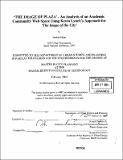| dc.contributor.advisor | Joseph Ferreira, Jr. | en_US |
| dc.contributor.author | Kim, Jaecheol, 1971- | en_US |
| dc.contributor.other | Massachusetts Institute of Technology. Dept. of Urban Studies and Planning. | en_US |
| dc.date.accessioned | 2006-03-24T18:20:13Z | |
| dc.date.available | 2006-03-24T18:20:13Z | |
| dc.date.copyright | 2004 | en_US |
| dc.date.issued | 2004 | en_US |
| dc.identifier.uri | http://hdl.handle.net/1721.1/30108 | |
| dc.description | Thesis (M.C.P.)--Massachusetts Institute of Technology, Dept. of Urban Studies and Planning, 2004. | en_US |
| dc.description | Some pages folded. | en_US |
| dc.description | Includes bibliographical references (p. 111-113). | en_US |
| dc.description.abstract | This thesis is a case study of how the design issues of a community web space can be approached from the viewpoint of urban design not in terms of appearance but in terms of its functionality. An urban public place like a plaza and a community web space both serve their residents' social lives whether real or virtual. There have been many efforts to replicate public spaces into the virtual world. However, considering the completely different materials that compose both spaces, it may be not proper to duplicate just the visual appearance of a city in the virtual world. Therefore, in this thesis, using not the literal adoption of but the functional analogy of urban design, I analyze the legibility of a community web space, 'PLAZA'. This analogy can be divided into two parts. The first part utilizes Kevin Lynch's methodology for the analysis of "the Image of City". I examine the design of PLAZA using the public's mental image of PLAZA, as he used the citizens' image of cities to analyze city spaces. The second part uses physical urban space to interpret the relation between users' mental image of PLAZA and its design. Spatial concepts that are familiar in designing physical spaces are used for this analysis; Graphic, Location, Vitality of a place, and Accessibility. The result of this case study shows both similarities and dissimilarities between an urban public space and DUSP PLAZA for each spatial concept. | en_US |
| dc.description.statementofresponsibility | by Jaecheol Kim. | en_US |
| dc.format.extent | 113 p. | en_US |
| dc.format.extent | 6866274 bytes | |
| dc.format.extent | 6866082 bytes | |
| dc.format.mimetype | application/pdf | |
| dc.format.mimetype | application/pdf | |
| dc.language.iso | eng | en_US |
| dc.publisher | Massachusetts Institute of Technology | en_US |
| dc.rights | M.I.T. theses are protected by copyright. They may be viewed from this source for any purpose, but reproduction or distribution in any format is prohibited without written permission. See provided URL for inquiries about permission. | en_US |
| dc.rights.uri | http://dspace.mit.edu/handle/1721.1/7582 | |
| dc.subject | Urban Studies and Planning. | en_US |
| dc.title | "The Image of PLAZA" : an analysis of an academic community web space using Kevin Lynch's approach for "The image of the city" | en_US |
| dc.type | Thesis | en_US |
| dc.description.degree | M.C.P. | en_US |
| dc.contributor.department | Massachusetts Institute of Technology. Department of Urban Studies and Planning | |
| dc.identifier.oclc | 55695105 | en_US |
